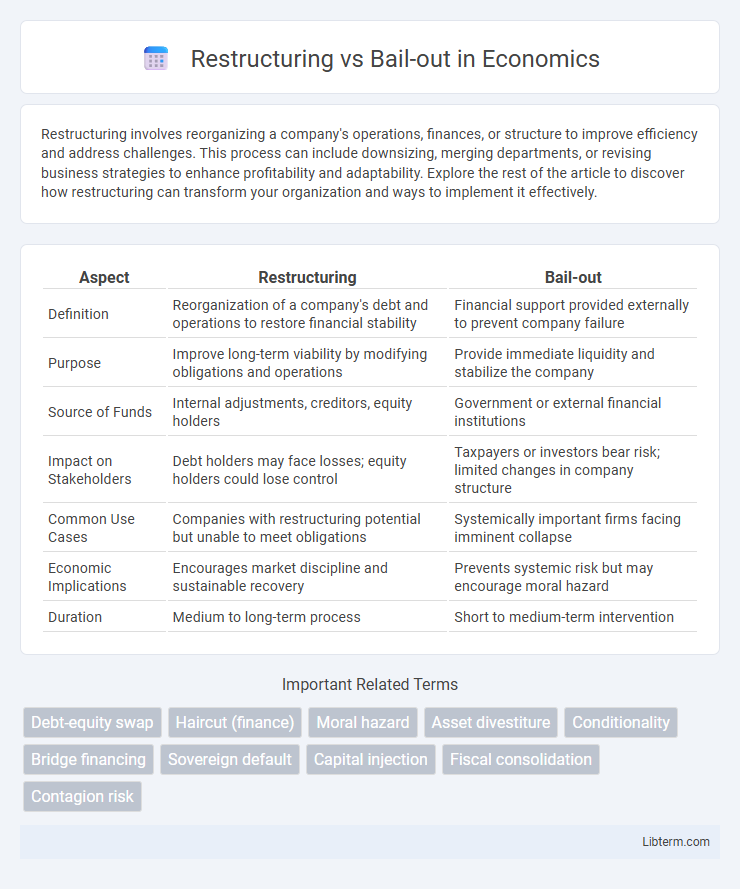Restructuring involves reorganizing a company's operations, finances, or structure to improve efficiency and address challenges. This process can include downsizing, merging departments, or revising business strategies to enhance profitability and adaptability. Explore the rest of the article to discover how restructuring can transform your organization and ways to implement it effectively.
Table of Comparison
| Aspect | Restructuring | Bail-out |
|---|---|---|
| Definition | Reorganization of a company's debt and operations to restore financial stability | Financial support provided externally to prevent company failure |
| Purpose | Improve long-term viability by modifying obligations and operations | Provide immediate liquidity and stabilize the company |
| Source of Funds | Internal adjustments, creditors, equity holders | Government or external financial institutions |
| Impact on Stakeholders | Debt holders may face losses; equity holders could lose control | Taxpayers or investors bear risk; limited changes in company structure |
| Common Use Cases | Companies with restructuring potential but unable to meet obligations | Systemically important firms facing imminent collapse |
| Economic Implications | Encourages market discipline and sustainable recovery | Prevents systemic risk but may encourage moral hazard |
| Duration | Medium to long-term process | Short to medium-term intervention |
Introduction: Understanding Corporate Crisis Solutions
Restructuring involves reorganizing a company's operations, liabilities, and assets to improve financial stability and long-term viability during a corporate crisis. A bail-out provides immediate financial assistance, often from external entities like governments or investors, to prevent insolvency and maintain operational continuity. Distinguishing between these solutions is crucial for selecting the appropriate approach to resolve corporate distress efficiently.
Defining Restructuring and Bail-out
Restructuring involves making fundamental changes to a company's operations, financial structure, or management to improve efficiency and ensure long-term viability. Bail-out refers to financial assistance provided by external entities, such as governments or investors, to prevent insolvency or collapse of a company facing severe financial distress. While restructuring focuses on internal adjustments, bail-outs primarily provide immediate liquidity support to stabilize the organization.
Key Differences Between Restructuring and Bail-out
Restructuring involves reorganizing a company's operations, debt, or structure to improve financial stability and long-term viability, often including measures like asset sales or renegotiation of terms. A bail-out typically refers to external financial assistance provided to prevent a company's collapse, usually through government funding or loans to stabilize immediate liquidity issues. Key differences include restructuring focusing on internal changes for sustainable recovery, while bail-outs rely on external support to avert insolvency.
When is Restructuring the Best Option?
Restructuring is the best option when a company faces long-term financial distress but has a viable business model and potential for recovery. It allows for debt renegotiation, operational improvements, and strategic realignment without sacrificing the company's existence, preserving stakeholder value more effectively than a bail-out. This approach is particularly suitable when market conditions are favorable for turnaround, and management commits to sustainable changes.
Circumstances Favoring a Bail-out
Circumstances favoring a bail-out typically include situations where the failing entity has systemic importance, meaning its collapse could trigger widespread economic disruption or financial contagion. Bail-outs are often considered when the business has viable long-term prospects but faces temporary liquidity problems due to external shocks such as financial crises or pandemics. Governments and regulators prefer bail-outs in scenarios where preserving jobs, maintaining market stability, and protecting consumer confidence outweigh the moral hazard concerns and fiscal costs.
Impact on Stakeholders: Employees, Investors, and Management
Restructuring often involves significant operational changes that can lead to layoffs or altered roles, impacting employees' job security and morale, while investors may face diluted shares but potentially benefit from long-term value preservation. Management typically gains more control and responsibility during restructuring, aiming to stabilize the company and improve performance. In contrast, a bail-out provides immediate financial relief from external sources, stabilizing investors' stakes and safeguarding jobs temporarily, but may impose stringent conditions limiting management's autonomy and increasing external oversight.
Financial Consequences of Each Approach
Restructuring typically involves negotiating debt terms, reducing liabilities, and improving cash flow, which can stabilize a company and preserve shareholder value while potentially damaging credit ratings. Bail-outs inject external capital, often from government sources, preventing immediate insolvency but resulting in increased public debt and moral hazard risks. Financially, restructuring aims for long-term viability with lower cost to taxpayers, whereas bail-outs provide short-term relief but may burden the economy with higher fiscal deficits.
Long-term Outcomes: Sustainability and Recovery
Restructuring focuses on long-term sustainability by altering debt terms and operational strategies to enable recovery and growth, minimizing future financial risks. Bail-outs provide immediate financial relief but often lack mechanisms for lasting structural improvements, risking recurrence of financial distress. Sustainable recovery is more likely through restructuring, as it addresses underlying issues and promotes organizational resilience.
Case Studies: Notable Restructuring and Bail-out Examples
Notable restructuring cases include General Motors' 2009 Chapter 11 bankruptcy, where the company reorganized operations to return to profitability by shedding debt and renegotiating labor contracts. In contrast, the 2008 bail-out of AIG involved a $182 billion government intervention to stabilize the financial system without immediate operational overhaul. These examples highlight how restructuring focuses on internal transformation, while bail-outs provide immediate financial support to prevent collapse.
Conclusion: Choosing the Right Path for Troubled Companies
Choosing the right path for troubled companies depends on their financial health, long-term viability, and stakeholder interests. Restructuring offers a strategic approach to improve operational efficiencies and debt management, while bail-outs provide immediate liquidity but may lead to increased dependency on external funding. Careful analysis of cash flow forecasts, market conditions, and regulatory implications guides decision-makers toward the most sustainable solution.
Restructuring Infographic

 libterm.com
libterm.com